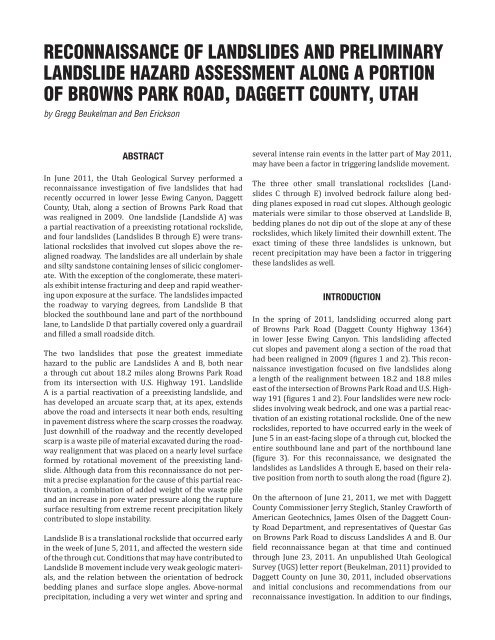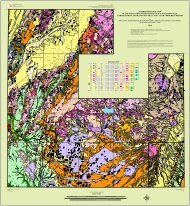Reconnaissance of landslides and preliminary landslide hazard
Reconnaissance of landslides and preliminary landslide hazard
Reconnaissance of landslides and preliminary landslide hazard
You also want an ePaper? Increase the reach of your titles
YUMPU automatically turns print PDFs into web optimized ePapers that Google loves.
RECONNAISSANCE OF LANDSLIDES AND PRELIMINARY<br />
LANDSLIDE HAZARD ASSESSMENT ALONG A PORTION<br />
OF BROWNS PARK ROAD, DAGGETT COUNTY, UTAH<br />
by Gregg Beukelman <strong>and</strong> Ben Erickson<br />
ABSTRACT<br />
In June 2011, the Utah Geological Survey performed a<br />
reconnaissance investigation <strong>of</strong> five <strong>l<strong>and</strong>slides</strong> that had<br />
recently occurred in lower Jesse Ewing Canyon, Daggett<br />
County, Utah, along a section <strong>of</strong> Browns Park Road that<br />
was realigned in 2009. One l<strong>and</strong>slide (L<strong>and</strong>slide A) was<br />
a partial reactivation <strong>of</strong> a preexisting rotational rockslide,<br />
<strong>and</strong> four <strong>l<strong>and</strong>slides</strong> (L<strong>and</strong>slides B through E) were translational<br />
rockslides that involved cut slopes above the realigned<br />
roadway. The <strong>l<strong>and</strong>slides</strong> are all underlain by shale<br />
<strong>and</strong> silty s<strong>and</strong>stone containing lenses <strong>of</strong> silicic conglomerate.<br />
With the exception <strong>of</strong> the conglomerate, these materials<br />
exhibit intense fracturing <strong>and</strong> deep <strong>and</strong> rapid weathering<br />
upon exposure at the surface. The <strong>l<strong>and</strong>slides</strong> impacted<br />
the roadway to varying degrees, from L<strong>and</strong>slide B that<br />
blocked the southbound lane <strong>and</strong> part <strong>of</strong> the northbound<br />
lane, to L<strong>and</strong>slide D that partially covered only a guardrail<br />
<strong>and</strong> filled a small roadside ditch.<br />
The two <strong>l<strong>and</strong>slides</strong> that pose the greatest immediate<br />
<strong>hazard</strong> to the public are L<strong>and</strong>slides A <strong>and</strong> B, both near<br />
a through cut about 18.2 miles along Browns Park Road<br />
from its intersection with U.S. Highway 191. L<strong>and</strong>slide<br />
A is a partial reactivation <strong>of</strong> a preexisting l<strong>and</strong>slide, <strong>and</strong><br />
has developed an arcuate scarp that, at its apex, extends<br />
above the road <strong>and</strong> intersects it near both ends, resulting<br />
in pavement distress where the scarp crosses the roadway.<br />
Just downhill <strong>of</strong> the roadway <strong>and</strong> the recently developed<br />
scarp is a waste pile <strong>of</strong> material excavated during the roadway<br />
realignment that was placed on a nearly level surface<br />
formed by rotational movement <strong>of</strong> the preexisting l<strong>and</strong>slide.<br />
Although data from this reconnaissance do not permit<br />
a precise explanation for the cause <strong>of</strong> this partial reactivation,<br />
a combination <strong>of</strong> added weight <strong>of</strong> the waste pile<br />
<strong>and</strong> an increase in pore water pressure along the rupture<br />
surface resulting from extreme recent precipitation likely<br />
contributed to slope instability.<br />
L<strong>and</strong>slide B is a translational rockslide that occurred early<br />
in the week <strong>of</strong> June 5, 2011, <strong>and</strong> affected the western side<br />
<strong>of</strong> the through cut. Conditions that may have contributed to<br />
L<strong>and</strong>slide B movement include very weak geologic materials,<br />
<strong>and</strong> the relation between the orientation <strong>of</strong> bedrock<br />
bedding planes <strong>and</strong> surface slope angles. Above-normal<br />
precipitation, including a very wet winter <strong>and</strong> spring <strong>and</strong><br />
several intense rain events in the latter part <strong>of</strong> May 2011,<br />
may have been a factor in triggering l<strong>and</strong>slide movement.<br />
The three other small translational rockslides (L<strong>and</strong>slides<br />
C through E) involved bedrock failure along bedding<br />
planes exposed in road cut slopes. Although geologic<br />
materials were similar to those observed at L<strong>and</strong>slide B,<br />
bedding planes do not dip out <strong>of</strong> the slope at any <strong>of</strong> these<br />
rockslides, which likely limited their downhill extent. The<br />
exact timing <strong>of</strong> these three <strong>l<strong>and</strong>slides</strong> is unknown, but<br />
recent precipitation may have been a factor in triggering<br />
these <strong>l<strong>and</strong>slides</strong> as well.<br />
INTRODUCTION<br />
In the spring <strong>of</strong> 2011, l<strong>and</strong>sliding occurred along part<br />
<strong>of</strong> Browns Park Road (Daggett County Highway 1364)<br />
in lower Jesse Ewing Canyon. This l<strong>and</strong>sliding affected<br />
cut slopes <strong>and</strong> pavement along a section <strong>of</strong> the road that<br />
had been realigned in 2009 (figures 1 <strong>and</strong> 2). This reconnaissance<br />
investigation focused on five <strong>l<strong>and</strong>slides</strong> along<br />
a length <strong>of</strong> the realignment between 18.2 <strong>and</strong> 18.8 miles<br />
east <strong>of</strong> the intersection <strong>of</strong> Browns Park Road <strong>and</strong> U.S. Highway<br />
191 (figures 1 <strong>and</strong> 2). Four <strong>l<strong>and</strong>slides</strong> were new rockslides<br />
involving weak bedrock, <strong>and</strong> one was a partial reactivation<br />
<strong>of</strong> an existing rotational rockslide. One <strong>of</strong> the new<br />
rockslides, reported to have occurred early in the week <strong>of</strong><br />
June 5 in an east-facing slope <strong>of</strong> a through cut, blocked the<br />
entire southbound lane <strong>and</strong> part <strong>of</strong> the northbound lane<br />
(figure 3). For this reconnaissance, we designated the<br />
<strong>l<strong>and</strong>slides</strong> as L<strong>and</strong>slides A through E, based on their relative<br />
position from north to south along the road (figure 2).<br />
On the afternoon <strong>of</strong> June 21, 2011, we met with Daggett<br />
County Commissioner Jerry Steglich, Stanley Crawforth <strong>of</strong><br />
American Geotechnics, James Olsen <strong>of</strong> the Daggett County<br />
Road Department, <strong>and</strong> representatives <strong>of</strong> Questar Gas<br />
on Browns Park Road to discuss L<strong>and</strong>slides A <strong>and</strong> B. Our<br />
field reconnaissance began at that time <strong>and</strong> continued<br />
through June 23, 2011. An unpublished Utah Geological<br />
Survey (UGS) letter report (Beukelman, 2011) provided to<br />
Daggett County on June 30, 2011, included observations<br />
<strong>and</strong> initial conclusions <strong>and</strong> recommendations from our<br />
reconnaissance investigation. In addition to our findings,

















